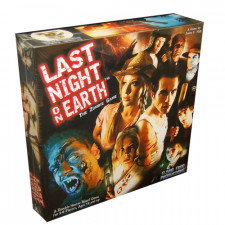Last Night on Earth: The Zombie Game Review
on Jun 23, 2015
Strip away the production values, and Last Night on Earth is the board game you and your friends wanted to design in junior high. Sure, it’s more developed and well-thought-out than the tripe you dreamed up and prototyped on the inside of a pizza box. But at its heart, the game captures the soul of what you wanted out of a board game when you were 14: hilarious events, rolling for movement, lots of dicey combat, a bit of strategy and a lot of luck, and a narrative you can talk about over cans of Mountain Dew for years to come. Still, there’s enough meat on its bones to keep you coming back, even when your high school days are far behind you.
Fast, “infected†zombies are ubiquitous nowadays, but Last Night on Earth takes us back to the drooling, shuffling, supernatural undead of B-movies past. Pitting one or two zombie players against a team of four survivors, the narrative will slowly build from tense creeping around the board to crazy, over-the-top, desperate last stands. The rules might not excite upon a first or second reading: you’ll roll dice to move, roll more dice to fight, and draw cards to find weapons and helpful events. The scenario card will dictate the end goal, but typically the survivors will be trying to accomplish a mission while the zombies will attempt to stop them and feast on the brain buffet.
But just reading the rules can’t convey just how much happens when a game of Last Night on Earth gets rolling. The farm girl takes a final stand against the teeming hordes, her chainsaw bringing seven zombies back to the grave with her as she breathes her last. The sheriff screams, “Go on without me!†as he leaps from the truck, drawing the monsters away from the escape vehicle so his friends can make it to safety. Somehow, the randomness in the decks, dice, and modular boards coalesce to tell a satisfying story almost every time I sit down to play it. Embrace the chaos, and the game will reward you and your play group.
The combat system has been designed to punish unarmed heroes dumb enough to challenge zombies in melee combat. This is really the engine that drives the game’s story arc forward, as heroes will be scrambling around the town looking for weapons and power-ups before they’re finally brave enough to start taking down the Zs. Can the hermit keep frantically searching for a gun for one more turn in the police station, or should he make a break for the zombie-free airplane hangar? These are the push-your-luck challenges that make up the bulk of the heroes’ tactical decisions. A few combat rounds can be herky jerky as players lay cards down one after the other, trying to gain the upper hand, but for the most part it’s a smooth and smart system that knows what it wants to be and doesn’t try to do too much.
The game could have come with just one solid scenario and retained a ton of its variability. I’ve played over three dozen sessions, and the undisputed majority have been the “Escape in the Truck†scenario. This is because the game relies on its thick stack of cards for most of the driving narrative, and the event and item cards can totally alter the course of the game. Yet Flying Frog has thrown all sorts of crazy goodies in the box: a healthy dose of varied scenarios, heroes, locations, advanced rules, and different game modes. What’s more, the online support has been phenomenal for the game, with custom fan-made and official scenarios popping up constantly. For those with the cash, expansions offer more heroes, a levelling system, more boards and settings, and a richer zombie player experience.
So, variety, narrative, buckets of dice: what’s not to love? While most sessions are highly memorable affairs, it’s possible for one of the teams can get knocked out early. As with any game that relies so heavily on chance, if the card draws come up in the right or wrong order, either the zombies or the heroes can be playing from behind right out of the gate. Since the game’s strength lies in the tension of the fast-building plot, a session with a foregone conclusion is a total dud. This doesn’t happen often, but if it does a few times in a row, it can leave a sour taste in the players’ mouths.
For a game that’s a simple experience at heart, there’s a bit of a learning curve. The rulebook isn’t especially well-structured, and teaching the intricacies of the phases and subsystems to newcomers requires communicating quite a few details, exceptions, and distinctions right from the start. This issue doesn’t really hinder the game’s accessibility so long as one experienced player is willing to run the zombies and hold the newbies’ hands along the way. I’ve managed to shorten my teaching time to a scripted 10-minute spiel, but it’s not always a walk in the park to get fidgety gamers to pay attention even to a brief explanation.
Despite my love for this game, I’ve got to admit it’s not for everyone. With plenty of rules and timing issues and a possibility for sessions to go lopsided, it will fall flat with some groups. But those willing to press on will find one of the most unparalleled story generators in modern gaming. It’s that good, and it’s worth wading through Last Night on Earth’s more grating idiosyncrasies to discover. You owe it to your inner pimple-faced teenager to give it a shot.

 Customer Support
Customer Support  Subscribe
Subscribe 




 Account
Account  Wishlist
Wishlist 

